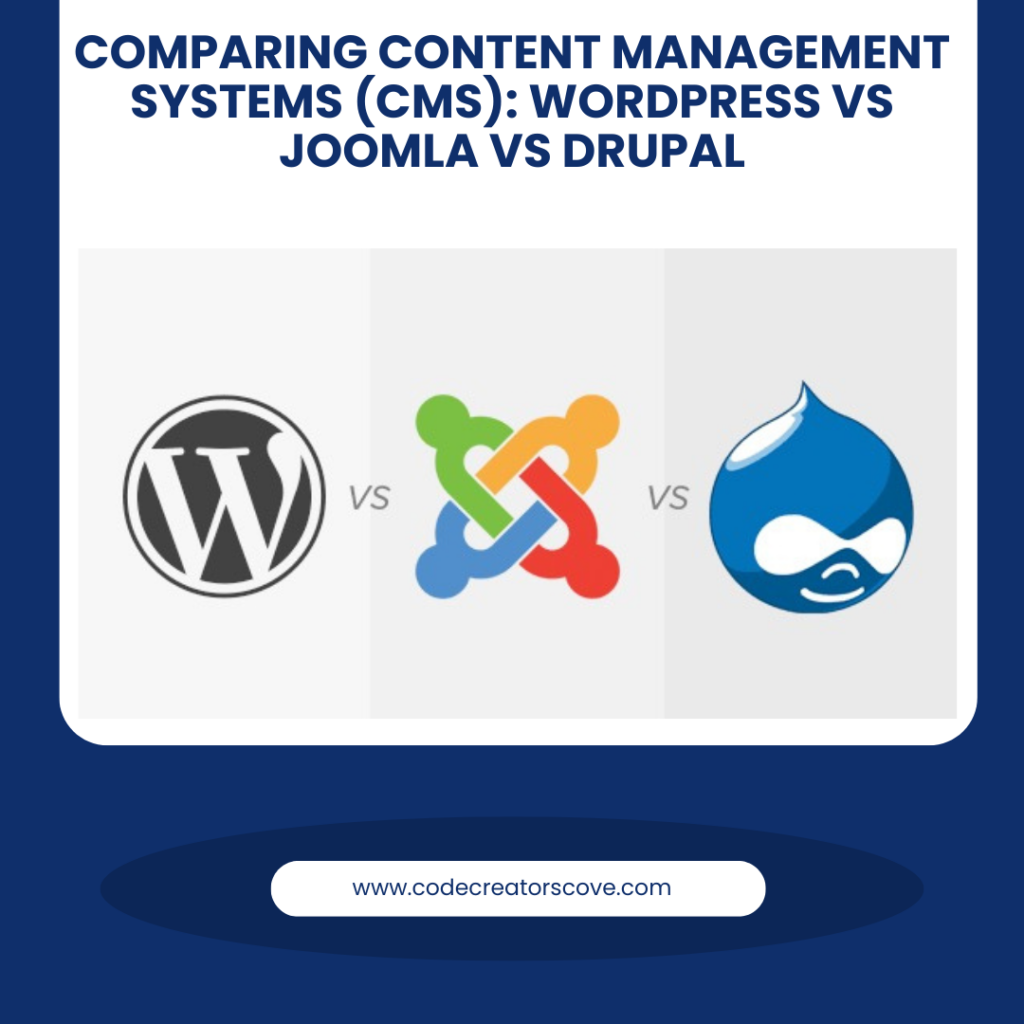In the vast expanse of the digital world, where every click leads to a plethora of content, Content Management Systems (CMS) stand as the silent architects, enabling individuals and organizations to create, curate, and control their online presence. Among the myriad of CMS options available, three giants such as WordPress, Joomla, and Drupal dominate the landscape, each offering its own set of features and functionalities tailored to meet diverse needs. In this article, we embark on a journey to dissect and compare these CMS, shedding light on their strengths, weaknesses, and unique propositions to empower you with the knowledge necessary to make an informed choice for your digital endeavors.
What is Content Management Systems (CMS)?
Content Management Systems (CMS) are software applications or platforms designed to facilitate the creation, management, and modification of digital content, primarily for websites and online platforms. These systems provide users with intuitive interfaces and tools to efficiently organize, publish, and update various types of content, including text, images, videos, and documents, without requiring extensive technical expertise.
At their core, CMS platforms consist of a backend interface where users can create and edit content, manage user roles and permissions, and customize the design and functionality of their websites. The content entered into the CMS is typically stored in a database, allowing for easy retrieval and manipulation.
One of the key features of CMS is its ability to separate content from presentation, enabling users to change the look and feel of their websites without affecting the underlying content. This separation of concerns allows for greater flexibility and scalability, as websites can easily adapt to changing design trends and technological advancements.
CMS platforms often come with a variety of built-in features and functionalities, such as content scheduling, search engine optimization (SEO) tools, and user authentication, as well as the ability to extend their capabilities through plugins, modules, or extensions developed by third-party developers.
WordPress
With an impressive footprint encompassing approximately 40% of all websites on the internet, WordPress emerges as the undisputed champion of CMS platforms. Its ascendancy can be attributed to its intuitive user interface, robust plugin ecosystem, and unparalleled versatility. Whether you’re a novice blogger or a seasoned developer, WordPress greets you with open arms, offering a seamless experience enriched by a vast array of themes and plugins.
From personal blogs to e-commerce websites, WordPress adapts effortlessly to various use cases, providing a solid foundation upon which digital dreams are built. However, despite its widespread popularity, WordPress is not without its limitations. As websites scale in complexity and traffic, the need for optimization and performance tweaks becomes more apparent, requiring users to delve deeper into the intricacies of WordPress customization and management.
Joomla
Stepping into the ring alongside WordPress is Joomla, a formidable contender renowned for its flexibility and scalability. Positioned as the middle ground between user-friendliness and advanced functionality, Joomla caters to a diverse audience ranging from small businesses to large enterprises. Its robust access control system and multilingual capabilities make it a preferred choice for organizations with complex content management needs.
Unlike WordPress, which often targets beginners and non-technical users, Joomla appeals to those seeking a balance between ease of use and extensive features. However, navigating Joomla’s learning curve may prove challenging for some, as it requires a deeper understanding of its architecture and functionalities compared to its WordPress counterpart. Furthermore, while Joomla boasts a respectable selection of extensions and templates, its ecosystem may not rival the sheer breadth and depth of WordPress plugins and themes.
Drupal
At the pinnacle of CMS sophistication stands Drupal, a powerhouse favored by developers and enterprises seeking unparalleled customization and scalability. With a modular architecture and robust API support, Drupal empowers users to craft bespoke websites and web applications tailored to their exact specifications. From government portals to multinational corporations, Drupal serves as the backbone of digital experiences that demand uncompromising security and scalability.
However, with great power comes great complexity, and Drupal’s learning curve can be daunting for newcomers. Unlike WordPress and Joomla, which prioritize accessibility and ease of use, Drupal requires a deeper understanding of web development principles and best practices to unlock its full potential. Nevertheless, for those willing to invest the time and effort, Drupal rewards them with a level of control and flexibility unmatched by its competitors.
Comparison Between WordPress, Joomla, and Drupal
As we stand at the crossroads of WordPress, Joomla, and Drupal, it becomes imperative to weigh their respective strengths and weaknesses against our individual needs and aspirations.
Ease of Use: WordPress reigns supreme in user-friendliness, offering a seamless experience for beginners and non-technical users. Joomla strikes a balance between simplicity and complexity, catering to a more diverse audience with varying skill levels. Drupal, while powerful, may intimidate newcomers with its steep learning curve and technical requirements.
Scalability: Drupal emerges as the undisputed champion in scalability, capable of handling the most demanding of digital experiences with grace and resilience. WordPress and Joomla, while scalable to a certain extent, may require additional optimization and customization to accommodate large-scale projects.
Customization Options: WordPress dazzles with its vast library of themes and plugins, providing endless possibilities for customization and personalization. Joomla and Drupal offer extensive customization options as well but may require more technical expertise to implement advanced features and functionalities.
Community Support: WordPress boasts the largest and most active community, providing a wealth of resources, tutorials, and support forums for users of all levels. Joomla and Drupal also have vibrant communities, albeit smaller in scale, offering ample opportunities for collaboration and knowledge sharing.
Conclusion
In the ever-evolving landscape of digital content management, the choice of CMS is not merely a matter of preference but a strategic decision that can shape the trajectory of your online presence. WordPress, Joomla, and Drupal each offer a unique set of features and capabilities suited to different use cases and user profiles. Whether you’re a blogger, a business owner, or a seasoned developer, there’s a CMS out there waiting to bring your digital vision to life. By understanding the strengths and weaknesses of WordPress, Joomla, and Drupal, you can embark on your digital journey with confidence, knowing that you’ve chosen the right tool for the job.


